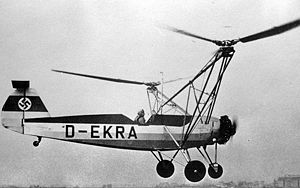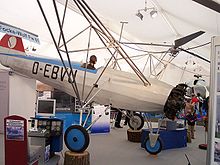avia.wikisort.org - Helicopter
The Focke-Wulf Fw 61 is often considered the first practical, functional helicopter, first flown in 1936.[1] It was also known as the Fa 61, as Focke began a new company—Focke-Achgelis—in 1937.[citation needed]
This article needs additional citations for verification. (June 2021) |
| Fw 61 | |
|---|---|
 | |
| Fw 61, which flew Hanna Reitsch | |
| Role | Helicopter |
| Manufacturer | Focke-Wulf Focke-Achgelis |
| First flight | 26 June 1936 |
| Introduction | 1936 |
| Primary user | Nazi Germany |
| Number built | 2[1] |
Design and development

Professor Henrich Focke, through his development of the Fw 186, and through the efforts of producing the C.19 and C.30 autogyros under licence,[2] came to the conclusion that the limitations of autogyros could be eliminated only by an aircraft with a powered rotor, the helicopter. He and engineer Gerd Achgelis started the design for this helicopter in 1932. A free-flying model, built in 1934 and propelled by a small two-stroke engine, brought the promise of success. Today, the model can be seen in the Deutsches Museum in Munich.[citation needed]
On 9 February 1935, Focke received an order for the building of a prototype, which was designated the Fw 61; Focke referred to it as the F 61. Roluf Lucht of the technical office of the RLM extended the order for a second aircraft on 19 December 1935. The airframe was based on that of a well-tried training aircraft, the Focke-Wulf Fw 44 Stieglitz.[citation needed]
Using rotor technology licensed from the Cierva Autogiro Company, a single radial engine drove twin rotors, set on tubular steel outriggers to the left and right of the fuselage.[2] Each main rotor consisted of three articulated and tapered blades, driven by the engine through gears and shafts. Longitudinal and directional control was achieved using cyclic pitch and asymmetric rotor lift.[3] The counter-rotation of the two rotors solved the problem of torque-reaction as also shown by Louis Bréguet. The small horizontal-axis propeller directly driven by the engine was purely to provide the necessary airflow to cool the engine during low speed or hovering flight and provided negligible forward thrust.[4][2]
Only two aircraft were produced.[1] The first prototype, the V 1 D-EBVU, had its first free flight on 26 June 1936 with Ewald Rohlfs at the controls.[4] By early 1937, the second prototype, V 2 D-EKRA, was completed and flown for its first flight. On 10 May 1937, it accomplished its first autorotation landing with the engine turned off.[citation needed]
Focke-Achgelis began work on a two-seat sports version of the Fw 61, the Fa 224, which would have used an Argus As 10C engine and had greater performance. However, the Fa 224 never left the drawing board at the outbreak of World War II.[5]
Operational history

In February 1938, the Fw 61 was demonstrated by Hanna Reitsch indoors at the Deutschlandhalle sports stadium in Berlin, Germany.[6][7] It subsequently set several records for altitude, speed and flight duration culminating, in June 1938, with an altitude record of 3,427 m (11,243 ft),[2] breaking the unofficial 605 m (1,985 ft) altitude record of the TsAGI 1-EA single lift-rotor helicopter from the Soviet Union set in August 1932, and a straight line flight record of 230 km (143 mi).[citation needed]
Neither of these machines appear to have survived World War II, although a replica is on display at the Hubschraubermuseum in Bückeburg, Germany.[citation needed]
Specifications (Fw 61)

Data from Aircraft of the Third Reich[8]
General characteristics
- Crew: one
- Length: 7.3 m (23 ft 11 in) fuselage only
- Height: 2.65 m (8 ft 8 in)
- Empty weight: 800 kg (1,764 lb)
- Max takeoff weight: 950 kg (2,094 lb)
- Powerplant: 1 × Bramo Sh.14A 7-cyl. air-cooled radial piston engine, 119 kW (160 hp)
- Main rotor diameter: 2 × 7 m (23 ft 0 in)
- Main rotor area: 76.97 m2 (828.5 sq ft)
Performance
- Maximum speed: 112 km/h (70 mph, 60 kn) at sea level
- Cruise speed: 90 km/h (56 mph, 49 kn)
- Range: 230 km (140 mi, 120 nmi)
- Service ceiling: 3,427 m (11,243 ft)
- Rate of climb: 3.50 m/s (689 ft/min)
See also
Related development
- Focke-Achgelis Fa 223
Aircraft of comparable role, configuration, and era
- Flettner Fl 265
- Flettner Fl 282
- Gyroplane Laboratoire
- Sikorsky R-4
References
Notes
- Goebel, Greg. "European Helicopter Pioneers." vectorsite.net. Retrieved: 10 October 2015.[unreliable source?]
- Ford, Roger (2013). Germany's Secret Weapons of World War II. London, United Kingdom: Amber Books. p. 224. ISBN 9781909160569.
- J.R.Smith; Antony L. Kay (1972). "Focke-Wulf Fw 61". German Aircraft of the Second World War. Retrieved 6 June 2015.
- J.R.Smith; Antony L. Kay (21 April 1938). "Helicopter Progress". Flight: 380–3.
- "Focke-Achgelis Fa 224".
- Ruffin 2005, p. 19.
- Smith, Frank (1981). Legacy of Wings; The Harold F. Pitcairn Story. New York: Jason Aronson, Inc. p. 261-262. ISBN 0876684851.
- Green 2010, pp. 356–357.
Bibliography
- Coates, Steve and Jean-Christophe Carbonel. Helicopters of the Third Reich. Crowborough, UK: Classic Publications Ltd., 2002. ISBN 1-903223-24-5.
- Green, William. Aircraft of the Third Reich, Vol.1. London: Aerospace Publishing Limited, (First ed.) 2010. ISBN 978-1-900732-06-2.
- Nowarra, Heinz J. German Helicopters, 1928–1945. Atglen, Pennsylvania: Schiffer Publishing, 1990. ISBN 0-88740-289-5.
- Ruffin, Steven A. Aviation's Most Wanted: The Top 10 book of Winged Wonders, Lucky Landings and Other Aerial Oddities. Washington D.C.: Potomac Books, 2005. ISBN 1-57488-674-6.
- Smith, J. Richard. Focke-Wulf, an Aircraft Album. London: Ian Allan Ltd., 1973. ISBN 0-7110-0425-0.
- Smith, J. Richard and Anthony Kay. German Aircraft of the Second World War. London: Putnam & Company Ltd., 1972 (3rd edition 1978). ISBN 0-370-00024-2.
- Witkowski, Ryszard. Rotorcraft of the Third Reich. Redbourn, UK: Mushroom Model Publications, 2007. ISBN 978-83-89450-43-2.
External links
- French & German Helicopter Pioneers (Fa 61)
- Focke Wulf Fw61
- Henrich Focke—Fa 61
- Virtual Aviation Museum Focke Wulf FW 61
- Warbirds Resource Group
- German static replica
- Focke Wulf Fw 61 luftwaffe at YouTube
- Vertical Rewind: Spoils of War Archive
На других языках
[de] Focke-Wulf Fw 61
Die Focke-Wulf Fw 61 (später als Focke-Achgelis Fa 61 bezeichnet) war ein Versuchs-Hubschrauber, mit dessen Konstruktion Henrich Focke bereits 1932 begonnen hatte. Nach seinen Entwürfen wurden bei der von ihm und Georg Wulf 1923 gegründeten Focke-Wulf Flugzeugbau AG in den Jahren 1935 und 1936 unter Anwendung des Prinzips der seitlichen Rotoren zwei Exemplare gebaut. Sie erwiesen sich schnell als die ersten gebrauchsfähigen Hubschrauber der Welt.- [en] Focke-Wulf Fw 61
[fr] Focke-Wulf Fw 61
Le Focke-Wulf Fw 61 (désigné plus tard Focke-Achgelis Fa 61) était un hélicoptère expérimental construit par Henrich Focke en 1932, qui marqua le début de la carrière d'hélicoptériste de ce dernier. Il s'avéra rapidement que c'était le premier modèle d'hélicoptère entièrement fonctionnel au monde. Il fut réalisé en deux exemplaires dans les années 1935-1936 par la société Focke-Wulf (Focke-Wulf Flugzeugbau AG), fondée en 1923 par Henrich Focke et Georg Wulf.[it] Focke-Wulf Fw 61
Il Focke-Wulf Fw 61, indicato successivamente anche come Focke-Achgelis Fa 61, era un elicottero sperimentale monoposto progettato da Henrich Focke in collaborazione con Gerd Achgelis e realizzato dall'azienda tedesca Focke-Achgelis & Co., GmbH su richiesta della Focke-Wulf Flugzeugbau negli anni trenta.[ru] Focke-Wulf Fw 61
Focke-Wulf Fw 61 — одноместный двухвинтовой вертолёт поперечной схемы. Является первым вертолётом, который обладал достаточной устойчивостью на всех режимах полёта и хорошей управляемостью[1].Другой контент может иметь иную лицензию. Перед использованием материалов сайта WikiSort.org внимательно изучите правила лицензирования конкретных элементов наполнения сайта.
WikiSort.org - проект по пересортировке и дополнению контента Википедии